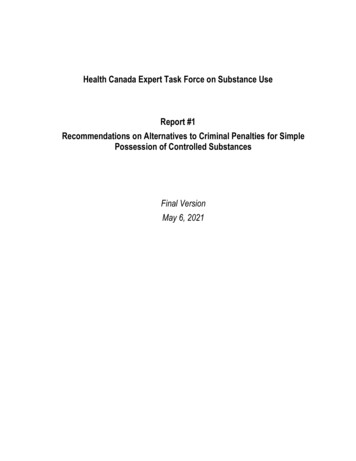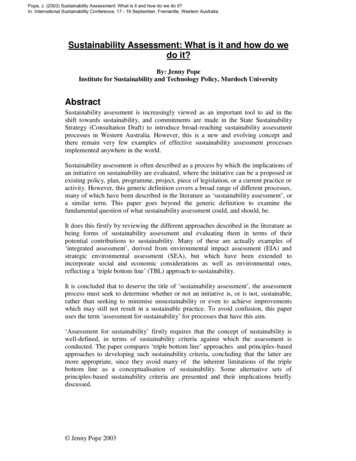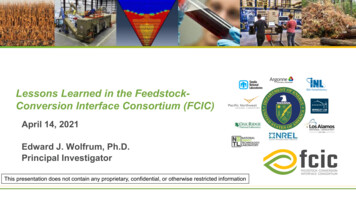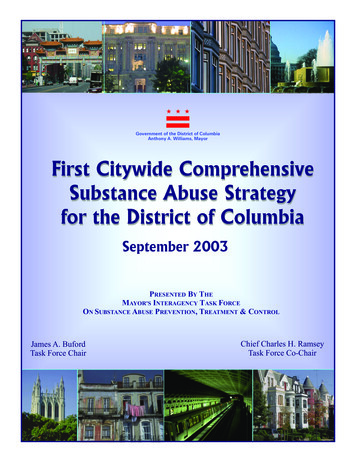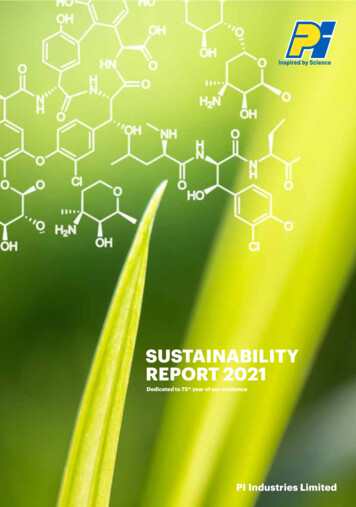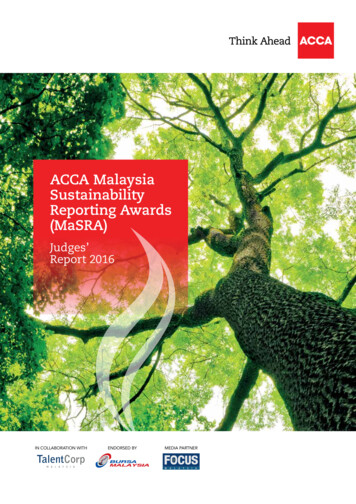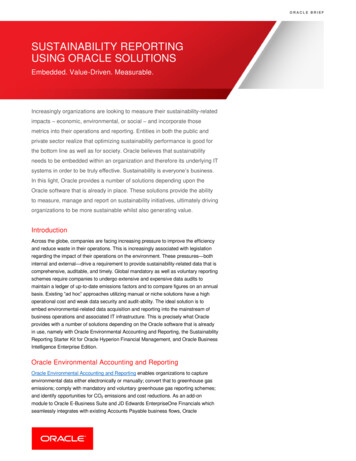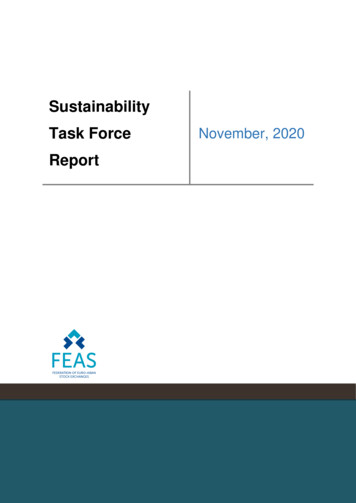
Transcription
SustainabilityTask ForceReportNovember, 2020
Sustainability Task Force - 2020Federation of Euro-Asian Stock Exchanges (FEAS)November 2020Sustainability Task Force ReportFederation of Euro-Asian Stock Exchanges5b Mher Mkrtchyan str.0010, Yerevan, ArmeniaT: 374 44 737-727www.feas.orgii
Sustainability Task Force - 2020ContentsIntroduction . 4Sustainability and Impact Investing . 5Characteristics of impact investing . 5How big is the impact investing market? . 6Public policy background . 9Climate . 9Development. 10Mobilising civil society . 11In faith . 11Tri Hita Karana. 13In the market . 14Mobilising business . 14Mobilising entrepreneurship . 14Mobilising finance . 15Impact investors. . 15COVID-19 and ESG . 17iii
Comparative Analysis of Member Market Fee StructuresIntroductionThe launching of FEAS Sustainability taskforce in 2019 aimed at promotingsustainability at the market level and exchange level by encouraging FEAS members toincorporate the sustainability practices into their daily operations, promoting and enhancethe ESG reporting and disclosure at the FEAS.The first sustainability report issued in 2019 identified the current sustainabilityinitiatives, trends, challenges and opportunities among FEAS member exchangesthrough conducting online survey to measure the performance of FEAS members withrespect to basic sustainability market data and indices, membership and commitment,and finally the ESG disclosure and reporting.The report concluded with FEAS Sustainability Roadmap that consists of four mainpillars, the Sustainability Responsibilities and Oversight, Sustainability Reporting andDisclosures, Sustainable Financial Products, and Sustainability Awareness.This year the report is tackling the role of exchanges in promoting sustainability duringpandemic times, with the spread of Covid-19 the need to more transparent disclosuresreporting the performance of listed companies in the ESG issues.4
Sustainability Task Force - 2020Sustainability and Impact InvestingDue to what the world faced in the period of COVID-19, it is proven that we cannotcontrol and hedge unsystematic risks. Therefore, there is a huge and strong demandfrom investors on “sustainability reporting” with the increasing concerns about Health andSafety Policies, The Supply Chain and Business Continuity Plan (BCP). Sustainabilityreporting enables listed companies to consider their impacts on a wide range ofsustainability issues, enabling them to be more transparent about the risks andopportunities and communicating sustainability performance and impacts.Stakeholders also play a crucial role in identifying these risks and opportunities fororganizations, particularly those that are non-financial. This increased transparency leadsto better decision making, which helps build and maintain trust in businesses andgovernments.Not only the demand on sustainability reporting and transparency is expected toincrease due to the pandemic, but the demand on ESG investments & Impact investingas well. Impact investing is a relatively new term, used to describe investments madeacross many asset classes, sectors, and regions.According to the Global Impact Investing Network (GIIN), the Impact investmentsare investments made with the intention to generate positive, measurable social andenvironmental impact alongside a financial return. Impact investments can be made inboth emerging and developed markets, and target a range of returns from below marketto-market rate, depending on investors' strategic goals.The growing impact investment market provides capital to address the world’s mostpressing challenges in sectors such as sustainable agriculture, renewable energy,conservation, microfinance, and affordable and accessible basic services includinghousing, healthcare, and education.Characteristics of impact investing1: Intentionality: An investor’s intention to have a positive social or environmentalimpact through investments is essential to affect investing. Investment with Return Expectations: Impact investments are expected togenerate a financial return on capital or, at minimum, a return of capital.1Thegiin.org (Global Impact Investing Network)5
Sustainability Task Force - 2020 Range of Return Expectations And Asset Classes: Impact investments targetfinancial returns that range from below market (sometimes called concessionary)to risk-adjusted market rate, and can be made across asset classes, including butnot limited to cash equivalents, fixed income, venture capital, and private equity. Managing Impact Performance: Impact investing comes with a specific intentionand necessitates that investments be managed towards that intention. Thisincludes having feedback loops in place and communicating performanceinformation to support others in the investment chain to manage towards impact. Contribute to The Growth of The Industry: Investors with credible impact investingpractices use shared industry terms, conventions, and indicators for describingtheir impact strategies, goals, and performance. They also share learnings wherepossible to enable others to learn from their experience as to what actuallycontributes to social and environmental benefit.How big is the impact investing market?Impact investing is a relatively new term, used to describe investments madeacross many asset classes, sectors, and regions. In 2019 for the first time, the GIINdeveloped a rigorous methodology to estimate the total size of the market. Since thisinaugural market sizing effort, the GIIN has strengthened its database andmethodology to continually improve its approach and on June 11, 2020, the GIINpublished the 2020 ANNUAL IMPACT INVESTOR SURVEY, which includes anupdated market sizing analysis, which estimates the current market size at USD715 billion.This analysis examines the supply of capital allocated to impact investing as ofthe end of 2019, using impact-investing AUM as the indicator of market size. The GIINestimates that over 1,720 organizations manage USD 715 billion in impact investingAUM as of the end of 2019. The market comprises a range of investor types, in termsof characteristics like organization type, headquarters location, and investor size.At the investor side, the size of ESG-dedicated funds is considerably smaller ataround 1 trillion, or around a 2% share of the market. In terms of geographies,Europe and North America accounted for more than 90% of the market in 2018. (JPMorgan)6
Sustainability Task Force - 2020Source: UBS BankMoreover, for investors who focus on ESG issues, there was some comfort tobe found in the relative resilience of high-rated ESG funds.Source: MSCI, UBS Asset Management, data from 31/12/20 to 31/5/20.At the FEAS member level, the performance of ESG indices are outperformingthe benchmark indices, for example the S&P/EGX ESG index outperformed theBenchmark index EGX30 index since first of March 2020, where the country imposedtotal lockdown on 19th March as shown in the following figure.7
Sustainability Task Force - 20208
Sustainability Task Force - 2020Public policy backgroundClimateThe Vienna Convention for the Protection of the Ozone Layer was signed in 1985and established a research and reporting framework – the Montreal Protocol, signed in1987 - for research into atmospheric change with a special focus on the reduction ofthe use of chlorofluorocarbons, because of the damage they had demonstrably doneto the ozone layer.The Montreal Protocol has been ratified by 196 countries and revised nine timessince it came into force, the last meeting taking place in Kigali, Rwanda in 2016. And itis judged to have worked: the ozone hole over Antarctica is being reduced and isprojected to return to 1980 levels between 2050 and 2070. A former Secretary-Generalof the U.N., Kofi Annan, called it, “the single most successful international agreementto date”.The United Nations Framework Convention on Climate Change is a treatynegotiated and signed by 154 states at Rio de Janeiro in 1992: the meeting was calledthe Earth Summit and the terms of the treaty require state signatories, classed in threedifferent groups by order of economic development, to take action and report on theeffectiveness of measures to control and limit anthropogenic climate change with theobjective of returning the emissions of industrialised countries to the levels of 1990 andassisting developing countries to meet their obligations. A Secretariat was establishedat Bonn to support this work.The Kyoto Protocol, which was entered into in 1997, was the first extension tothe UNFCCC. Kyoto set targets for advanced economies to cut emissions ofgreenhouse gases. The United States signed but subsequently withdrew and theremaining signatories did not achieve compliance.Kyoto in turn was superseded by the Accord de Paris or Paris Agreement, whichwas agreed in December 2015 and came into force in 2016: it now has 197 signatoriesincluding all U.N. member states, the European Union and the two UN GeneralAssembly observers, the State of Palestine and the Holy See. On 1 June 2017 theUnited States signalled it would withdraw from ratification of the agreement. On 28October 2020 Vice-President Joseph R. Biden declared the U.S. would return. TheU.S. was responsible for 14.3 per cent of global carbon emissions in 2015.9
Sustainability Task Force - 2020The Paris Agreement may be understood as a response to intense worldwidecriticism of non-compliance and provides that all signatories will bind themselves tolimit global warming to two degrees centigrade above pre-industrial atmospherictemperatures and try to limit it to 1.5 degrees.The supreme decision-making body of the UNFCCC is the Conference ofParties, which regularly meets in session, and the provisions of the Paris Agreementare therefore often referred to as COP21. The next meeting of the Conference of theParties is COP26 which will take place in Scotland in November 2021.DevelopmentThe Millennium Summit of the United Nations at New York in September 2000made a Declaration which was unanimously adopted by member states and observersand led to the elaboration of eight Millennium Development Goals with the objective ofreducing extreme poverty globally by 2015.In the years before 2015 substantial work was done inter-governmentally on theagenda for future development. In the same year as the Paris Agreement or COP21,the adoption of the 2030 Agenda for Sustainable Development established the GlobalGoals, otherwise known as the Sustainable Development Goals.10
Sustainability Task Force - 2020The SDGs are described by the U.N. as a shared blueprint for peace andprosperity for people and the planet, now and in the future. Each goal includes targets,events and processes for achievement with measurement and indicators.In September 2019, with ten years left to achieve the Sustainable DevelopmentGoals, world leaders met at the U.N. in New York City in a High Level Political Forumand after reviewing progress adopted a Political Declaration re-affirming the SDGs andcalling for a Decade of Action. More than 100 ‘Acceleration Actions’ were announcedat the meeting.The inter-governmental policy position is therefore clear, and around the worldnational plans have been prepared under both the Paris Agreement and, increasingly,the 2030 Agenda for Sustainable Development.The conclusion is that governments cannot do this by themselves. The Decadeof Action contemplates mobilising civil society, and we shall examine this furtherbelow. It also identifies the vital need to mobilise business and commerce,entrepreneurship and finance: in fact without that mobilisation, the SDGs will not beachieved.The financing gap to achieve the SDGs in countries developing their economiesis estimated by UNCTAD to be of the order of USD 2.5 to 3 TN annually to 2030. Itwould appear this is eminently possible to fund entirely from the private sector: thestock of gross global private sector financial assets is estimated at USD 200 TN(Allianz Global Wealth Report, 2018). The question is, why isn’t our financial systemdoing that already and how do we transform the financial system so that asset-ownerscan and do mobilise that capital for sustainable development, and a socially justtransition to a carbon-zero international economy?Mobilising civil societyIn faithThe second encyclical of Pope Francis was published by the Holy See in May2015 and is entitled Laudato Si and with the subtitle ‘On care for our common home’ itlaments the relentless exploitation and degradation of the natural world and thedestruction of the diversity of its animal and plant life. Poorer nations are particularly illequipped to adapt to the effects of climate change, will bear the brunt of it and do nothave the resources to achieve a just transition. Global poverty, in other words, is in the11
Sustainability Task Force - 2020view of the Church inextricably linked to anthropogenic climate change and rectifying itis therefore a moral issue for the wealthy nations which first benefited byindustrialisation and international trade. Of course SDG 1 is to eliminate povertyeverywhere.In the same year, 2015, the Islamic Climate Declaration called believers to rejectand dismiss human greed for natural resources and instead respect the created worldand be good stewards. In 2018 at Edinburgh, the Islamic Finance Council UK and theChurch of Scotland made a joint declaration of the result of two years of work todevelop a shared values framework for ethical finance.In October 2020, the Holy Father issued a second encyclical, entitled FratelliTutti. In this encyclical the Pope reflects on the parable of the Good Samaritan andagain criticises a throwaway culture and selfishness which is below human dignity anddestructive of the natural world humanity shares.The Ecumenical Patriarch and Archbishop of Constantinople, Bartholomew I hasfrom the beginning used his office to speak in support of the environmental movement,inviting his congregation in particular to recognise the reality of man-made globalwarming and the need to restore human respect of the natural world.Under Catholicos Karekin II the Armenian Apostolic Church has produced aseven year ecological action plan, in which it is stated, “that global environmentalchallenges can be solved only through the solidarity and joined efforts of faithcommunities, governments and civil society and development organisations”. The plan12
Sustainability Task Force - 2020has a particular focus on sustainable forestry, protecting soil and clean air, all of whichare priorities under SDG 15.Tri Hita KaranaInspired by faith traditions in Bali, Indonesia, and formed by the government ofIndonesia, the Tri Hita Karana initiative has been developed. It orders the SDGs in apyramid of achievement.The THK has been supported by the World Bank and the OECD and extensivework is now being done on how development banks can create and mobilise blendedfinance as one solution to address the funding gap preventing achievement of theSDGs.13
Sustainability Task Force - 2020In the marketOn the high street there are many initiatives to responsible consumption, thecritical analysis of supply-chains and value-chains and increasingly even a fashion ofsustainability. In 2020 there is a prestige associated with achieving sustainability.This is to be welcomed but it creates the risk that sustainability in any particularindustrial sector or activity or product will be promised and not delivered. Onceobserved, this practice is called “green-washing”. Just as civil society organisationscelebrate the commitment to sustainability by manufacturers and energy suppliers theyare quick to criticise its absence, and to examine with increasing rigour the growthplans and the procurement plans that are published. People don’t take thepronouncement on trust. Social media can be a powerful tool for holding business toaccount in this way.Mobilising businessTo encourage confidence in their sustainability and prevent the charge that theyare green-washing, businesses can declare a purpose: not simply to trade profitablybut to do it sustainably, and report annually on progress. The data gathered andreported in this way is useful to analysts as well as aggregators of nationalperformance. Of course it is also valuable to investors.U.N. Global Compact welcomes businesses prepared to embrace their tenprinciples and enter into partnership to achieve the goals.Beyond that, businesses can seek recognition from standards bodies: completingthe B Impact Assessment, for example, or seeking certification. There are now 3,500 BCorps across 70 countries.Mobilising entrepreneurshipNew business creation can be a powerful force for achieving sustainability,especially if entrepreneurs have social impact in mind as they establish theirenterprise. When Mohammed Yunus was awarded the Nobel Peace Prize in 2006, forhis creation of Grameen Bank, the idea of social entrepreneurship was recognised bythe world. It was a striking idea that a socially valuable intervention can be made notby a grant but by starting and operating a business or a bank.14
Sustainability Task Force - 2020At the World Economic Forum in Davos, in January 2020, a new initiative namedCatalyst 2030 was launched to identify, profile, catalyse and scale socialentrepreneurship as a necessary and systematic intervention in the economy with thepurpose of working directly to the Sustainable Development Goals.Mobilising financeWho invests in social entrepreneurship?Impact investors.The term ‘impact investing’ was coined at a 2007 meeting in Italy, hosted by theRockefeller Foundation. The meeting catalysed the creation of the Global ImpactInvesting Network (GIIN) which defines impact investing as follows:“Impact investments are investments made with the intention to achieve positivemeasurable social and environmental impact alongside a financial return”.According to the GIIN the size of the impact investment market in 2020 was USD715 BN, twice the size predicted in 2015.It is helpful to locate impact investment as a strategy on a table: the table is thespectrum of capital allocation by intensity of impact and is given below.It will be clear from the table that impact investing is at the perimeter ofinvestable sustainability strategies. Firstly, it is purposeful: social and environmentalimpact is deliberately achieved and not accidental to the investment. Secondly, it is astrategy where the question arises of whether returns on capital invested are at the15
Sustainability Task Force - 2020market rate for the risk and the asset. Thirdly, because it demands new datadisclosure and standards if measurement and evaluation of impact is to take place.Fourthly, because governments play a decisive role, and may even be market-building.Finally, because it invites the beneficiaries of the investment to have a voice inreporting success or otherwise.Impact investing to date has used private markets in fund creation, fixed incomeand private equity as well as infrastructure: the opportunity is to enable it on publicmarkets.A possible set of principles for an issuer of equity could look like this:1.The board of the company, acting by its chairman or chief executive;2.Proposes a theory of change;3.Which is to be achieved by the operation of its core business;4.For specific beneficiaries;5.Making a measurable impact as well as a financial return;6.Which is reported annually;7.Indexed on the Sustainable Development Goals;8.And reviewed for improvement.For a fixed-income issuer, the exchange would examine the purposes set out inthe prospectus and the application of funds. Best practice would include theexpectation that funds were segregated after closing and invested under a time-limitedstrategy in identifiable projects.To conclude, in 2018, before the epidemic of COVID-19, it was reported that theworld was not on track to achieve the Sustainable Development Goals. In fact,according to the Social Progress Index, the world is on track to achieve them calingsocialentrepreneurship and impact investing on public markets, could make all the differencealongside supportive public policy.In September 2020 the Climate Action Tracker estimated on current policies notpledges the atmosphere will heat by 2.7 to 3.1 degrees C above pre-industrial levelsby 2100. That isn’t sustainable.16
Sustainability Task Force - 2020COVID-19 and ESGThe world after COVID-19 - can sustainability strategies and impact investinghelp us understand what comes next and how we as stock exchanges and FEASmembers can influence it?The COVID-19 pandemic has had far-reaching consequences beyond the spreadof the disease, it also had a substantial influence on politics, social and environmentalmatters. The COVID-19 accelerated many trends in the global economy, mostprominent ones could be considered digitalization of the world economies byincreasing digital behavior and increased consideration of sustainable investment. TheCOVID-19 pandemic consequences illustrate us two obvious trends – the first is thenecessity to recover the economy from the influences of pandemic and the other oneis following sustainability goals as a reconsideration of investing approach. Manyinvestment funds perceive the importance of ESG as undoubtable and therefore preferto lay out money in those following ESG sustainability goals. Many investors argue thatthe consequences of COVID-19 pandemic are even worse than the consequences ofWorld War II and that it is the first sustainability crisis which renewed the attention onclimate change, healthcare, and on other social and environmental questions, byacting as a wake-up call for decision makers to prioritize a more sustainable approachto investment.Financial market infrastructures are the main sources of raising capital andthey were also negatively affected by the COVID-19 pandemic. According to OliverWyman the market infrastructure firms will play an even more crucial role in thefinancial market ecosystem, maintaining functioning secondary markets as well ashelping the real economy recapitalize in primary markets, and supporting thecommunity more broadly in longer-term. Therefore, importance of financial marketinfrastructures during the COVID-19 crisis is undoubtable. Mostly stock exchanges hadto continue to operate despite the pandemic and during the pandemic there have beencommon changes in the work of stock exchanges, which included the following:1.transition to the remote work of stock exchange employees;2.cancellation of public events and restriction of access to premises foroutsiders;3.developing and using web means of communication, during themeetings and votings;17
Sustainability Task Force - 20204.suspension of trading halls and a complete transition to e-commerce;5.growth in volatility and trading volumes on most stock exchanges;6.increased limits and collateral requirements.Currently, we can observe that there is a high risk of a second wave of pandemicwhich could lead to even worse consequences. Many countries have already startedclosing their cities which are facing second wave of COVID-19. Therefore, FEASorganization as a collaboration of exchanges around the world can make itscontribution by combining the stock exchanges experience together in order toproduce actions plans which would be contributing to recovery by the way ofsustainable development. Nearly every exchange during the COVID-19 pandemic hasundertaken measures to support their market participants by securing businesscontinuity, undertaken measures included the following: ban on short selling: Austria, Belgium, Greece, Malaysia, Italy, Korea; reduction of trading hours/temporary closing of trades: Serbia, Indonesia, SaudiArabia, Egypt, Philippines; Jordan, Maceonia, Philippines, Sri Lanka, Iraq; suspension of trading due to increased volatility: Egypt, Thailand; renewal of limits upon reaching which trades are suspended: Brazil, Egypt; temporary incentives on commission fees: Thailand, Malaysia, Luxembourg,China; extending reporting deadlines for members and issuers: Canada, Malaysia,Singapore, Jordan, Hong Kong, TMX Group charity donations: Canada, Jordan, Iran, Japan and Malta; reduced commission fees: China, Luxembourg and Thailand. 1.Stock exchangeTMX GroupActions undertaken in response to COVID-19 pandemicGranted additional reporting delays and amended the fees forlate feelings.2.Amman Stock ExchangeIncreased the trading duration from one to two hours and raisedthe price limits from 2.5% to 5%3.Bursa MalaysiaGranted fee waivers to encourage growth in fund-raising activitiesthrough listings on Bursa Malaysia which included fee waivers inprocessing fees, initial listing and annual listing fees.4.Singapore ExchangeSGX have committed 5 million SGX Care Package which have18
Sustainability Task Force - 2020gone towards supporting the community via national healthcaresupport programs including Community Chest's The CourageFund. Furhtermore, SGX granted automatic 60-day extension forissuers to hold their annual general meetings (AGMs).5.6.Dubai Gold &Dubai Gold & Commodities Exchange Group has implementedCommodities Exchangetravel and meeting restrictions, split-team and split-site workingGroupfor employees.The Egyptian ExchangeEGX as a precautionary measure to curb the spread ofcoronavirus pandemic, temporarily suspended all eventsrequiring gatherings and/or those requiring mobility betweencities, Egypt for Information Dissemination Company (EGID), asubsidiary of EGX, developed a web-based E-voting solutionenabling board members of a company to vote online.7.Iran Fara BourseIran Fara Bourse equips resources in confronting COVID-19outbreak crisis through the crowdfunding method.8.MOEX & KASEMOEX and KASE have developed action plans to ensureoperational continuity of its infrastructures under a variety ofscenarios depending on how the health in Russia, Kazakhstanevolves accordingly.9.Qatar Stock ExchangeQatar Stock Exchange has invoked its crisis management plan toensure the integrity of the market.Other specific actions undertaken by the exchanges, could be seen below:Hence, the COVID-19 pandemic has highlighted and even accelerated theimplementation of the concept of sustainable development, which has become thefocus of policymakers in many countries. The pandemic has clearly marked the socialvector of economic development in many countries. For instance, in Kazakhstaneconomic reforms adopted have become social in nature. As a result, these was anincreased number of issues and volumes in the bonds market to finance these reformsand infrastructure projects. In Kazakhstan, there was a shift in the volumes of placedliquidity from the corporate sector to the state sector due to a significant volume ofprimary placements of bonds of the Ministry of Finance of Kazakhstan and localgovernments which were implementing the state support programs (Governmentsecurities of the Ministry of Finance and local governments).19
Sustainability Task Force - 2020Regarding the governmental actions, there were unprecedented measuresundertaken which had enormous effect on the economy, the actions undertakeninclude the following:In the European Union, the Board of Governors of the European Central Bankdecided to launch a program of buyback of securities worth 750 billion euros to supportfinancial stability in the conditions of spreading coronavirus.In the UK, the Bank of England lowered interest rates to 0.25% and beganbuyback of bonds from the most significant companies to the economy.The government announced the adoption of a package of measures thatincluded: New financing schemes (for 30 billion pounds); Credit guarantees (for 330 billion pounds sterling); Deferred loan repayments.In Spain, the government provided 200 billion euros to support the economy,which included: Tax holidays; Credit lines; Credit guarantees.In Japan, as an incentive measure in connection with the coronavirus pandemic,the Bank of Japan doubled (to 112 billion US dollars) the buyback program ofexchange-traded index funds (ETFs), and also announced its intention to adjust thebuyback program of corporate bonds, increasing their amount by 18,5 billion USdollars until the end of September 2020.In Germany, the total amount of state support exceeded 750 billion euros: Direct subsidies to small businesses (50 billion euros); Funds for assistance of lar
the end of 2019, using impact-investing AUM as the indicator of market size. The GIIN estimates that over 1,720 organizations manage USD 715 billion in impact investing AUM as of the end of 2019. The market comprises a range of investor types, in terms of characteristics like organization type, headquarters location, and investor size.

